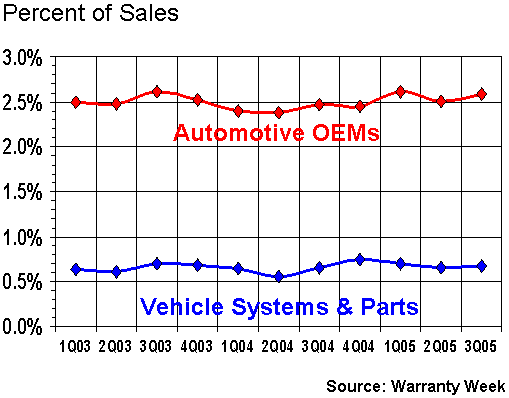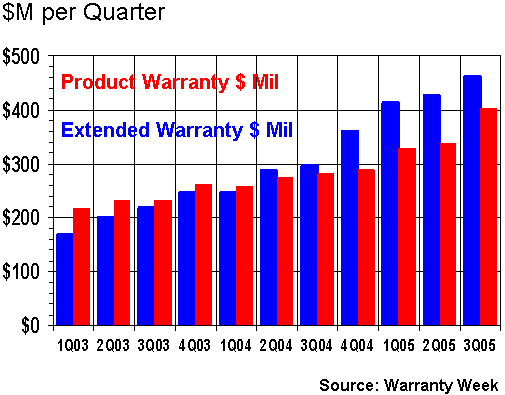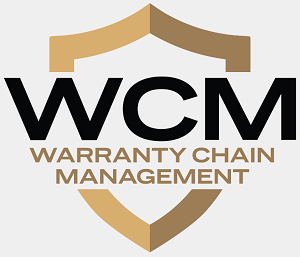Customer Recovery: While efforts to push warranty costs back onto suppliers have met with limited success, a handful of manufacturers have pushed most if not all of their warranty expenses back onto their customers.
Much is said about supplier recovery, the process of pushing warranty costs back to the suppliers whose components failed and produced the resulting claim. But not much is said about companies who push in the other direction, who get their customers to share the cost of warranty by making them pay more for products covered for longer durations.
Much has been written recently about manufacturers cutting back on their product warranties, thus making extended warranty purchases all the more appealing. At the very low end of the computer industry, for instance, some discount models are selling with nothing more than 90-day warranty coverage. Clearly, an extended warranty purchase would make more sense in such a case than if the unit was covered for one to three years.
In the appliance industry, some manufacturers have now cut back to one-year warranties. Or more precisely, in the old days the different components of a dishwasher, refrigerator, or clothes washer were typically covered for two, five, or even ten years, while the unit as a whole was covered for one year. Now everything is covered for just one year. Again, an extended warranty purchase can make a lot of sense in these cases.
If that extended warranty is sold by a retailer and administered by a third party, the manufacturer gets nothing. But if the manufacturer can somehow find a way to participate in the sale, either by selling the policies direct or by partnering with the retailers, then they can increase their revenue and hopefully their profits too.
Choose Your Own Warranty
We predict that even some manufacturers who go through retail will find ways to do this, perhaps by offering rebates to those who accept short warranties, or by some other means. Perhaps it will come down to the customer choosing the color of the unit, saying yes or no to the icemaker, and then selecting one, three, five, or ten years for the duration of the warranty. The first year is free but each additional year costs 5% extra.
One way to look at this trend would be to cast the manufacturers as big, bad greedy companies intent on raising profits by cutting back on guarantees. What's next, cheaper parts? Plastic instead of metal and vinyl instead of wood? Many consumers have long suspected that manufacturers build products a certain way so that they break down and they do wear out. Planned obsolescence, they call it. Hearing that a given manufacturer has cut back on product warranties would seem to confirm their suspicions.
But another way of looking at it is to assume that there is always going to be a predictable risk of product failure. How much risk is the manufacturer willing to keep, and how much is the consumer willing to assume? Few manufacturers would want their products to last forever, but selling junk that wears out quickly is not the way to build customer loyalty and encourage repeat purchases.
So let's say that all manufactured products have a 2% chance of failure during the first year, 4% during the second year, 8% during the third year, and 16% during the fourth year. If a product has a one-year warranty and a four-year extended warranty is priced at 15% of the unit's price, one might think it's priced appropriately given the risk. One might even purchase it. Now we're not saying these are the actual rates. But you get the idea: an extended warranty, also known as a service plan, is a way for the buyer to fix the cost of repairs up front. And the cost of the policy can be measured against the risk of failure, in order to judge its value.
Manufacturers spend a considerable amount of time looking for ways to push warranty costs back onto suppliers. While it's possible to do so, and perhaps even necessary, to make sure suppliers don't begin to look the other way when it comes to quality, so far in the past three years there has not been any meaningful shift between what suppliers pay and what OEMs pay. That's not to say that supplier recovery efforts have failed. It's just that the ratio between supplier and OEM has more or les remained the same.
Meanwhile, roughly 50 of the 900 manufacturers we track for quarterly warranty expenses have identified themselves as sellers of extended warranties, service contracts, or service plans. We suspect there are more manufacturers who sell them, but they simply forgot to disclose it in their annual reports. But the point is not compliance with some generally accepted accounting principles. The point is that roughly one out of 18 manufacturers has already found a way to get reimbursed for warranty expenses not only by their suppliers, but also by their customers.
Customer Recovery
So let's take a neutral stance on whether or not extended warranties are a good thing, and whether or not manufacturers should be selling them. Instead, let's look at both ends of the warranty chain, examining both supplier recovery efforts and what we're going to call customer recovery efforts. Overall, what we're finding is that OEMs can call themselves successful if they're recovering 15% or 20% of their warranty costs from their suppliers. But through the sale of extended warranties, at least three manufacturers have managed to recover 100% or more of their warranty costs from customers.
First, let's take a look at the automotive industry, where supplier recovery efforts are said to be more advanced than in other industries. For years, vehicle manufacturers have been doing their best to push at least some of their warranty costs back onto their suppliers. And while the warranty claims rates of some suppliers has increased over the past year or two, on average the percentage of revenue paid out by all suppliers has stubbornly remained more or less where it's been since 2003. Meanwhile, the claims rates of several OEMs has drifted upwards -- not by tremendous amounts, but the direction has been upwards, not downwards.
The following chart illustrates this lack of change. Over the past 11 quarters, the warranty claims rate for vehicle systems and parts suppliers has never been higher than 0.75%. For automotive OEMs, the claims rate has never been lower than 2.4%. And the gap, which stood at 1.9% between the OEMs and their suppliers at the end of September 2005, has never been wider.
Figure 1
Automotive Warranty Claims
OEMs vs. Suppliers
in % of Auto Sales Revenue
1Q 2003 to 3Q 2005
Automotive OEMs, including not only GM and Ford but also manufacturers of trucks, buses, RVs, motorcycles, forklifts, golf carts, and many other types of wheeled vehicles, are expected to finish out the year with a cumulative $11.5 billion in warranty claims (so far for nine months they've reported $8.4 billion). That will represent roughly 2.6% of their $448 billion or so in worldwide automotive product revenue.
Auto parts and component manufacturers, meanwhile, are likely to report close to $2.1 billion in warranty claims for 2005, equal to roughly 0.7% of their $310 billion in product revenue. That's virtually unchanged from the claims rate seen in 2004, but it's actually down from the 0.73% level seen in 2003.
Put them together and you have roughly 130 companies spending a collective $13.6 billion, or roughly 2.0% of their total product revenue, on warranty claims. That's the figure for funds paid to repair centers -- the gross amount of the auto warranty bill. Of that total outlay, 15% is reimbursed by suppliers and 85% is not.
Now let's look at the extended warranty segment. Although final figures for 2005 are not yet available, let's assume there was roughly 6.5% growth over 2004 levels, and that customers therefore paid roughly $16 billion in extended warranty premiums last year. Of that total, roughly $6 billion was automotive extended warranty, and of that segment, roughly $1.8 billion went to the auto OEMs (the balance went to third party administrators and to the dealerships).
Warranty Reimbursements
Now we have most of the elements of the supplier recovery and customer recovery equations. In 2005, according to our estimates, US-based automotive OEMs paid out $13.6 billion in claims and received $2.1 billion in reimbursements from suppliers. Therefore, supplier recovery efforts have returned around 15% to auto OEMs. We suspect it's the same story in appliances and computers: get back 15% from your suppliers and you're doing well.
The still-missing components include the portion of supplier warranty claims that were satisfied in the aftermarket (not passing through an OEM). Another unknown is the amount of claims posted against the extended warranty proceeds (the profit margin of the $1.8 billion in extended warranties). So while we can say that customer recovery efforts amounted to $1.8 billion, it would be wrong to make any assumptions about the profitability of that revenue. After all, it's possible that OEM-administered service plans are breakeven or even loss-producing activities. Those who pocket the huge profits are those who actually sell the extended warranties, not those who administer or insure them.
As was demonstrated in a June 2, 2004 article, the same gap exists between the consumer-facing brand name and their suppliers in the computer and the appliance industry. Dell and Whirlpool have the same problem as Ford and GM when it comes to supplier recovery. Knowing that a part failed does not in and of itself identify the cause of the failure. And even identifying the cause doesn't always lead to a reimbursement.
In the computer industry, there are also OEMs and suppliers. But it's harder to establish a believable warranty chain with the available data, because 1) not all semiconductors end up in computers, and 2) not all disk drives and peripherals are sold through OEMs. For that matter, much of the $1 billion or so expected to be reported as what we're calling semiconductor warranty claims will actually be paid by the makers of the production machinery to the makers of the semiconductors themselves.
But for the record, we're expecting computer OEMs to pay roughly $5.5 billion in claims for the full year and for disk drive, semiconductor, and peripheral manufacturers to pay roughly $2.5 billion. For OEMs that will represent around 3.3% of hardware sales, and for storage, chip, and peripheral makers around 0.8% of sales. So while the high-low claims relationship also exists between OEMs and suppliers in the computer industry, it's unlikely that most of the $2.5 billion was paid by suppliers to OEMs as reimbursements.
For the purposes of this article, it's therefore unlikely that OEMs paid out $8 billion and recovered $2.5 billion from suppliers. What's more likely is that OEMs paid out somewhere around $6.5 or $7 billion and recovered somewhere between $1 and $1.5 billion from suppliers. Then, what we're counting as computer suppliers spent the balance of their $2.5 billion total on claims payments to non-OEM customers and repair centers. In other words, if you're a printer manufacturer, half your claims came through OEMs who resell your units under their brand name and half your claims can from units that were sold with your name on the box.
Computer Customer Recovery
It's a confusing and highly speculative warranty chain. Perhaps a clearer and more reliable picture can be made using just one computer manufacturer's data. Dell doesn't release figures for its supplier reimbursements, but it does include detailed numbers for both product warranty and extended warranty in their financial statements. Its fiscal year concludes at the end of January, though, so we'll have to extrapolate for the full year based on just nine months of numbers.
Figure 2
Dell Inc.
Warranty Claims vs. Extended Warranty
in $M Recognized per Quarter
1Q 2003 to 3Q 2005
As this chart illustrates, Dell began taking in more warranty money than it was sending out sometime in the second quarter of 2004. That gap has continued to widen, to the point where Dell took in $462 million and sent out $402 million during the third quarter of 2005. But the size of the difference isn't what's important. What matters is that Dell has found a way to recover all of its warranty expenses from its customers.
As mentioned, Dell's fiscal year isn't quite over, so we're going to have to make some educated guesses. In round numbers, Warranty Week estimates that Dell began its current fiscal year with $2.1 billion in its product warranty reserve, that it will pay $1.6 billion in claims, and that it will accrue $1.7 billion to finance future claims, leaving it with around $2.2 billion in warranty reserves as of January 31, 2006. We further estimate that it began its fiscal year with $1.5 billion in deferred extended warranty revenue, that it sold $2.7 billion in new extended warranty policies, that it recognized $1.9 billion in extended warranty revenue, and that it ended the year with $2.3 billion in deferred revenue.
Let's assume that like the automakers, Dell's suppliers contributed around 15% to the company's claims total. In other words, let's assume Dell paid out $1.85 billion in claims, and it was reimbursed for $250 million, leaving a net outlay of $1.6 billion. Or perhaps Dell's supplier recovery efforts have been more successful than is typical. If the ratio was not 15% but 20%, that would mean Dell paid out $2 billion and was reimbursed for $400 million of that total, for the same net outlay of $1.6 billion.
When extended warranty revenue is included, it becomes clear that customers have reimbursed Dell for the remainder of the warranty bill, and then some. In the current fiscal year, purely on a cash flow basis, we're estimating that $2.7 billion in extended warranty premiums came in from customers, $250 to $400 million came in from suppliers, and $1.85 to $2 billion went out to pay for claims/repairs. On a recognized revenue basis, $1.9 billion collected from customers in the past was recognized during the current year, $250 to $400 million came in from suppliers as reimbursements, and $1.85 to $2 billion went out to customers and/or repair companies.
Profitable Warranties
Either way, in this fiscal year warranty was a profitable process for Dell. Even assuming minimum reimbursements and maximum claims, there was still a net positive contribution of at least $150 million. More likely, it was double that amount. In other words, while Dell might have recovered 15% or 20% from its suppliers, it recovered somewhere between 95% and 105% from its customers. Warranty has become a profitable enterprise.
One can only imagine what would happen if extended warranties were to become commonly sold by all OEMs -- even those who go through retailers. Or more precisely, imagine if the manufacturer allowed the customer to choose the price that reflects the risk of service cost that makes them most comfortable. Imagine if an automobile were priced at $18,000 with a 30-day warranty, $19,000 with a three-year warranty, and $21,000 with a ten-year warranty. In other words, the manufacturer projects the ten-year cost of service to be $3,000 on average. Do you as the customer want to play those odds? If not, you can buy the car with a minimal warranty and take your chances. If you spend less than $3,000 over the first ten years, you did the right thing. But you will only know this in hindsight.
Such a risk-sharing plan is already in effect for the low end of the computer industry. They're not cutting back to 90-day warranties because quality is plummeting. They're cutting back because after they've gone to China for their parts, India for their customer care, and Germany for their enterprise applications software, one of the few ways still available to bring the cost down is to shift some of the risk. That means the customer has to share more of the cost of repair: customer recovery.
What's a Warranty Worth?
When Dell sells a desktop computer for $299 and covers it with a 90-day warranty, they're looking for a buyer who loves low prices and lives with risk. You want a one-year warranty? Add an extra 10%. You want two years? That's another $50 on top of the $29 you pay for the first year. You want the full three-year extended warranty? That will cost you $139, an incredible 46% of the unit price.
We would assume that very few customers would buy the $299 computer with the $139 warranty, but who knows? A manufacturer could just as easily turn it around and offer a $438 computer with a $139 rebate if you don't want the three-year warranty at all, or a $60 rebate if you'll settle for just a year. Give up the warranty and get back money. In other words, warranty duration and risk sharing could easily become part of the sales negotiation, rather than something that's bundled into the price whether you want it or not.
Correction
The bundling of products and warranties as described above may in fact be illegal. A reader writes in with the following observations:
"In your paragraph on "What's a Warranty Worth?"
you mention a scenario of a higher price with a price rebate if the
consumer doesn't want the full warranty. If you're referring to a
"limited warranty" then I believe such a rebate is a violation of
Magnuson-Moss Warranty Improvement Act since one can't sell a limited warranty or imply there's a
price for the limited warranty through price manipulation.
"Alternatively, if you're referring to an extended warranty contract and
a retailer advertises a product's retail price that includes an extended
warranty contract and doesn't disclose it, then it's packing. Both are
bad. It would be a shame if a retailer or manufacturer went down this
path without understanding the subtleties."
| 










